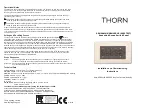
on clothes.
Try to hold a circuit board by its edges. Do not touch any components or the PCB.
Always wear an anti-static wrist strap when you touch any circuit board. For details, refer to
Static Discharge Damage Prevention.
System Grounding Requirements
A good grounding system is the basis for the stable and reliable operation of switches. It is the
chief condition to prevent lightning stroke and resist interference. The user must provide a good
grounding system. For details, refer to System Grounding Requirements.
Power Requirements
AC input voltage: 100-120V~, 200-240V~; 50/60Hz
AC input power: greater than the actual power consumption of the overall system.
Requirements of Installation Tools
Type
Tools
Remarks
Claw hammer, pliers
Unpack wooden case and
transportation case.
Phillips screwdriver,
flat
screwdriver, spanner
Disassemble chassis, power supply,
fan and modules.
Power cables, network cables,
optical fibers and distribution cables
Connect the interfaces.
Ruler, long tapeline, marker pen
Measure the installation position.
Common tools
Bolts, diagonal pliers, straps
Mount the chassis.
Anti-static tool
Prevent static electricity.
Special-purpose
tools
Wire stripper, crimping pliers
Create network cables and grounding
cables.
Multimeter
Test power supply and DC resistance.
Meter
500V megohmmeter
Test the insulation resistance and
grounding resistance.
Note: Users need to prepare some tools by themselves
.
Installation Requirements
Place the switch on the right place.
If you plan to mount RG-S12000 in a cabinet, you must verify that the cabinet meets the
following conditions:
Install the switch in an open cabinet. If you install the switch inside a closed cabinet, please
make sure that the cabinet has a good ventilation and heat dissipation system.
Make sure that the cabinet is firm enough to bear the weight of RG-S12000 and its
installation accessories.
Make sure that the dimensions of the cabinet are suitable, and that there is adequate
spacing in the four directions of RG-S12000 for heat dissipation.


































